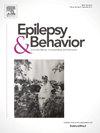Characteristics of patients diagnosed with psychogenic non-epileptic seizures (PNES) who request reinstatement of their driving privileges
IF 2.3
3区 医学
Q2 BEHAVIORAL SCIENCES
引用次数: 0
Abstract
Rationale: Patients who experience seizures, including PNES, are usually advised to discontinue driving, or have their driving privileges revoked until a determined period of seizure-freedom is achieved. In this retrospective study, patients with PNES who requested driving privileges or reported having resumed driving were compared to those who did not on measures of depression, anxiety, PTSD, and cognitive flexibility/motor speed.
Methods
Diagnosis of PNES was confirmed with video-EEG. Demographic and clinical data and requests for reinstatement of driving privileges (requiring 6 or more months seizure freedom) and reports of decisions to resume driving were noted. Tests of motor speed and hand eye coordination and self-report questionnaires of depression, anxiety and PTSD administered as part of neuropsychological assessment were analyzed.
Results
A total of 403 patients with PNES evaluated in 2010–2020 were identified. Of those, 365 patients were eligible for inclusion, and of those, 60 applied for driving privileges or reported that they resumed driving. When the two groups were compared, the group that applied for driving privileges or decided to resume driving was significantly less depressed (p = 0.001) when tested than the group that did not. Furthermore, a significant difference was seen in measures of motor performance between those who requested to resume driving and those who did not (DKEFS T1, p = 0.006, DKEFS T2, p = 0.001, DKEFS T3, p = 0.002, DKEFS T4, p = 0.001; GPT dominant, p = 0.05, GPT non-dominant, p = 0.003).
Conclusion
Driving a motor vehicle is a useful measure of improvement for PNES because patients with seizures are required to discontinue driving until seizure-freedom is achieved. This study revealed that lower levels of depression and better fine motor functioning were associated with reported seizure-freedom and driving resumption. Depression is commonly associated with diminished performance (slower motor response times and impaired fine motor movements) on tests of motor functioning, both of which may result in less interest in pursuing permission to resume driving. These findings suggest that mood symptoms (and associated performance on measures of motor speed and coordination) may have prognostic significance in patients diagnosed with PNES. This also suggests that timely treatment of depression in newly diagnosed patients with PNES may be indicated.
诊断为心因性非癫痫发作(PNES)的患者要求恢复其驾驶特权的特征。
理由:经历癫痫发作的患者,包括PNES,通常建议停止驾驶,或吊销驾驶特权,直到确定的癫痫发作自由期实现。在这项回顾性研究中,将要求驾驶特权或报告恢复驾驶的PNES患者与未要求驾驶特权的患者进行抑郁、焦虑、创伤后应激障碍和认知灵活性/运动速度的比较。方法:DiagnosisofPNESwasconfirmedwithvideo-EEG。注意到人口统计和临床数据、恢复驾驶特权的请求(需要6个月或更长时间的癫痫发作自由)和决定恢复驾驶的报告。运动速度和手眼协调测试以及抑郁、焦虑和创伤后应激障碍自我报告问卷作为神经心理学评估的一部分进行分析。结果:2010-2020年共发现403例PNES患者。其中,365名患者符合纳入条件,其中60人申请了驾驶特权或报告说他们恢复了驾驶。当两组进行比较时,申请驾驶特权或决定恢复驾驶的组在测试时明显比没有申请驾驶特权或决定恢复驾驶的组更少抑郁(p = 0.001)。此外,在要求恢复驾驶的人和没有要求恢复驾驶的人之间的运动表现测量中发现显着差异(DKEFS T1, p = 0.006, DKEFS T2, p = 0.001, DKEFS T3, p = 0.002, DKEFS T4, p = 0.001;GPT显性,p = 0.05, GPT非显性,p = 0.003)。结论:驾驶机动车是改善PNES的有效措施,因为癫痫发作的患者需要停止驾驶直到癫痫发作自由。这项研究表明,较低的抑郁水平和较好的精细运动功能与报告的癫痫自由发作和驾驶恢复有关。抑郁症通常与运动功能测试中的表现下降(运动反应时间变慢和精细运动受损)有关,这两种情况都可能导致寻求恢复驾驶许可的兴趣降低。这些发现表明,情绪症状(以及运动速度和协调的相关表现)可能对诊断为PNES的患者具有预后意义。这也提示新诊断的PNES患者可能需要及时治疗抑郁症。
本文章由计算机程序翻译,如有差异,请以英文原文为准。
求助全文
约1分钟内获得全文
求助全文
来源期刊

Epilepsy & Behavior
医学-行为科学
CiteScore
5.40
自引率
15.40%
发文量
385
审稿时长
43 days
期刊介绍:
Epilepsy & Behavior is the fastest-growing international journal uniquely devoted to the rapid dissemination of the most current information available on the behavioral aspects of seizures and epilepsy.
Epilepsy & Behavior presents original peer-reviewed articles based on laboratory and clinical research. Topics are drawn from a variety of fields, including clinical neurology, neurosurgery, neuropsychiatry, neuropsychology, neurophysiology, neuropharmacology, and neuroimaging.
From September 2012 Epilepsy & Behavior stopped accepting Case Reports for publication in the journal. From this date authors who submit to Epilepsy & Behavior will be offered a transfer or asked to resubmit their Case Reports to its new sister journal, Epilepsy & Behavior Case Reports.
 求助内容:
求助内容: 应助结果提醒方式:
应助结果提醒方式:


